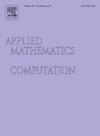具有避障和速度约束的机器人系统自触发控制:一种二重积分TTCBLF方法
IF 3.4
2区 数学
Q1 MATHEMATICS, APPLIED
引用次数: 0
摘要
针对具有避障和速度约束的机器人系统,提出了一种二重积分碰撞时间障碍李雅普诺夫函数(TTCBLF)方法。现有的障碍函数仅基于距离来评估碰撞风险,而忽略了与碰撞风险高度相关的机器人速度。为了综合评估碰撞风险,构建了一个柔性碰撞时间障碍函数(TTCBF),使机器人能够根据自身的速度和与障碍物的距离,提前动态地增加或减少原始障碍函数的幅度。然后,与单纯依赖控制信号的自触发机制(STM)不同,设计了基于速度约束函数的自触发机制,节省通信资源,最小触发间隔随着速度约束函数的增大而减小。通过Lyapunov方法和障碍函数的有界性分析表明,该方法在不违反速度约束的情况下实现了机器人系统的避障,同时排除了Zeno行为。最后,通过数值仿真验证了所提控制方法的有效性。本文章由计算机程序翻译,如有差异,请以英文原文为准。
Self-triggered control of robotic systems with obstacle avoidance and velocity constraints: A double integral TTCBLF approach
This article proposes a double integral time-to-collision barrier Lyapunov function (TTCBLF) approach for robotic systems with obstacle avoidance and velocity constraints. The existing barrier function assesses collision risk based solely on distance, neglecting the robot’s velocity, which is also highly relevant to collision risk. To comprehensively assess collision risk, a flexible time-to-collision barrier function (TTCBF) is constructed, enabling the robot to dynamically increase or decrease the amplitude of the original barrier function in advance based on its velocity and distances to obstacles. Then, unlike the self-triggered mechanism (STM) that solely depends on control signals, a velocity constraint function-based STM is designed to save communication resources, with the minimum triggering interval decreasing as the velocity constraint function increases. Through the Lyapunov method and boundedness analysis for the barrier function, it is shown that the proposed approach achieves obstacle avoidance for the robotic systems without violating the velocity constraints, while excluding the Zeno behavior. Finally, numerical simulations are provided to demonstrate the effectiveness of the proposed control approach.
求助全文
通过发布文献求助,成功后即可免费获取论文全文。
去求助
来源期刊
CiteScore
7.90
自引率
10.00%
发文量
755
审稿时长
36 days
期刊介绍:
Applied Mathematics and Computation addresses work at the interface between applied mathematics, numerical computation, and applications of systems – oriented ideas to the physical, biological, social, and behavioral sciences, and emphasizes papers of a computational nature focusing on new algorithms, their analysis and numerical results.
In addition to presenting research papers, Applied Mathematics and Computation publishes review articles and single–topics issues.

 求助内容:
求助内容: 应助结果提醒方式:
应助结果提醒方式:


